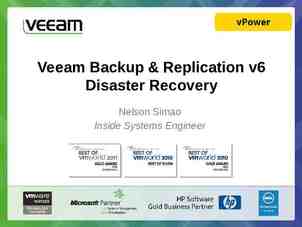Module 1 – Introduction About This Course Why Perform
23 Slides526.50 KB
Module 1 - Introduction About This Course Why Perform Penetration Tests? Security Certifications Types of Pentesting
About This Course Presenter Information Video Access Course Disks Network Configuration Certificate of Course Completion Course Support
About This Course Presenter Information Thomas Wilhelm ISSMP / CISSP / SCSECA / SCNA / SCSA / IAM IT Industry: 15 years Security Industry: 7 years U.S. Army SIGINT Analyst / Cryptanalyst Fortune 100 Penetration Testing / Risk Assessments Author “Penetration Tester’s Open Source Toolkit, Vol.2”
About This Course Video Access 30 days access to videos Use login information provided when enrolled 60 days to complete PenTest Document to ISSAF standards http://heorot.net/instruction/PTF/
About This Course Course Disks Disk 1.100 Used in Video Instruction Disk 1.101 Used in Hands-On Exercises & “Independent PenTest Effort” for Course Completion Certification BackTrack Used as Penetration Tester’s Toolkit
About This Course Network Configuration Configuration Issues: http://de-ice.net/index.php?name PNphpBB2&file viewforum&f 17 Can be used in a virtual machine
About This Course Certificate of Course Completion Awarded upon receipt and acceptance of formal documentation of Independent PenTest Effort Meet ISSAF standards “Independent PenTest Effort” uses Disk 1.101 Required material is covered in Module 4-8
About This Course Certificate of Course Completion - Grading General Documentation – 250 Management Summary Scope of the project (and Out of Scope parts) Tools that have been used (including exploits) Dates & times of the actual tests on the systems Identification of Weakness & Vulnerabilities – 650 A list of all identified vulnerabilities Output of tests performed (screenshots or “script” text file) Action Points – 100 Recommendation of what to mitigate first Recommended solution
About This Course Course Support Email: [email protected] Support 24x7 Instructor: [email protected] Online chat T,Th 9pm Eastern Also available by appointment Available via phone by appointment
Why Perform Penetration Tests? Black Hat vs. White Hat Code of Ethics Legal Responsibilities
Why Perform Penetration Tests? Code of Ethics CISSP Code of Ethics Canons: Protect society, the commonwealth, and the infrastructure. Act honorably, honestly, justly, responsibly, and legally. Provide diligent and competent service to principals. Advance and protect the profession.
Why Perform Penetration Tests? Black Hat vs. White Hat Black Hat: “A black hat is a person who compromises the security of a computer system without permission from an authorized party, typically with malicious intent” - Wikipedia White Hat: “A white hat hacker, also rendered as ethical hacker, is, in the realm of information technology, a person who is ethically opposed to the abuse of computer systems” - Wikipedia
Why Perform Penetration Tests? Legal Responsibilities Federal Mandates SOX HIPPA FISMA, etc. State Mandates California Senate Bill 1386 Many other states are following California’s Example
Security Certifications Generalized Knowledge Appliance-Specific Methodology
Security Certifications Generalized Knowledge (ISC)2 ISSMP / ISSAP / ISSEP / CISSP / SSCP Prosoft Learning Certified Internet Web Professional Program Designer / Administrator / Manager / Developer SANS Institute Global Information Assurance Certification GISF / GSEC / GCFW / GCIA / GCUX and more
Security Certifications Appliance-Specific CISCO CCSP / CCIE Check Point CCSA / CCSE RSA Security CSA / CSE TruSecure TICSA / TICSE Operating Systems SCSECA RHCSS MCSE: Security
Security Certifications Methodology National Security Agency IAM / IEM EC-Council CEH
Types of Penetration Testing Network Host Application Database
Types of Penetration Testing Network Password Switches / Routers Firewall Intrusion Detection VPN Storage WLAN Security Internet User Security AS400 Lotus Notes
Types of Penetration Testing Host Unix / Linux Windows Novell Netware Web Server
Types of Penetration Testing Application Web Application Source Code Auditing Binary Auditing
Types of Penetration Testing Database Database Security Social Engineering
Module 1 - Conclusion Why Perform Penetration Tests? About This Course Security Certifications Types of Pentesting







